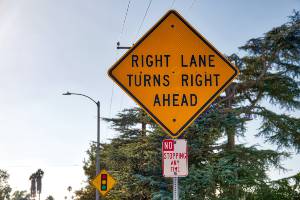 Right turns are not as dangerous as left turns. You are not turning in front of traffic that is heading in the opposite direction. Even if you pull out into the intersection too soon, you can speed up and other drivers can slow down to try to prevent a crash.
Right turns are not as dangerous as left turns. You are not turning in front of traffic that is heading in the opposite direction. Even if you pull out into the intersection too soon, you can speed up and other drivers can slow down to try to prevent a crash.
However, if you are making a left turn, the oncoming driver may be unable to slow down before a collision occurs. Even if you speed up, a collision may occur.
Although rights turns are less dangerous than left turns, crashes can still occur. While the driver making the turn is often at fault, this is not always the case. Sometimes the oncoming driver may bear some responsibility for the collision.
Below, we discuss how fault for a right-turn crash may be evaluated. If you were injured in such a crash, give us a call today to learn if you may have a case. We are ready to help crash victims secure compensation for their damages at no upfront cost.
Fault for Auto Accidents in Ontario
It is important to note that insurance companies use the Fault Determination Rules to assess fault for vehicle accidents. These rules outline various scenarios and how fault should be assigned in each scenario.
However, these scenarios do not account for the specific details of a crash, such as road conditions, visibility or weather. Insurance companies also have an incentive to blame the victim for a crash to try to avoid paying full compensation for the victim’s damages.
That is why it is so important to find an experienced lawyer to help you pursue full compensation for the damages you have suffered. You need an experienced advocate fighting for your best interests.
Who Has the Right of Way During a Right Turn?
If the turning driver has a red light, oncoming traffic has the right of way. That is why drivers attempting to make a turn at a red light need to wait for traffic to clear. You need to make sure you have enough time to make the turn and reach an appropriate speed to settle into the flow of traffic.
This is the reason drivers who turn right and get into a crash are often to blame. They may have pulled out too soon. Sometimes drivers who are turning do not realize how fast an oncoming car is traveling. They may have had an obstructed view of the road so they could not see an oncoming car.
It is possible the driver who was turning was not wearing his or her glasses or contact lenses. The driver may have failed to update the prescription on his or her glasses or contact lenses. This would be the fault of the driver.
Sometimes drivers make a right turn and do not speed up enough to get into the flow of traffic. In other words, the turn may have been safer if they had been quicker to speed up. The turning driver may be assessed with at least partial fault for the collision.
When Could Oncoming Drivers Be Held Liable?
There are situations where oncoming drivers may bear at least partial fault for a right-turn crash. For example, an oncoming driver may have changed lanes as the other driver was turning. The oncoming driver may have moved into the same lane the turning driver was turning into.
The oncoming driver may be at fault in this situation, particularly if he or she changed lanes in the middle of the intersection.
Another factor to consider is that oncoming drivers may have enough time to avoid a crash, even if the right-turning driver is negligent. If the oncoming driver had enough time to slow down or change lanes, the crash might be his or her fault.
Sometimes oncoming drivers are speeding or are distracted, which makes it harder for them to avoid a collision. If the oncoming driver was negligent and this is at least part of the cause of the crash, the oncoming driver likely bears liability.
If you are turning and you have a green light, you have the right of way. If you get rear-ended or T-boned by a car heading in the direction you are turning, the driver of the at vehicle would likely be at fault. The driver may have run through a red light, possibly because he or she was distracted or speeding.
Rear-End Crashes With Right-Turning Drivers
Sometimes drivers who are turning right were rear-ended by a car behind them. Typically, the rear driver is at fault for this type of crash.
Sometimes these crashes happen because the rear driver sees the lead car pull forward and the rear driver thinks the lead driver is going to turn. If the rear driver hits the gas a rear-end crash could result. In these situations, the rear driver is almost always going to be found at fault.
Contact Greg Monforton and Partners Today
For decades, the Windsor auto accident lawyers at Greg Monforton and Partners have been recovering compensation for those injured in vehicle collisions. We have obtained millions on behalf of our clients.
Free Consultation. No Upfront Fees. Call (866) 320-4770.